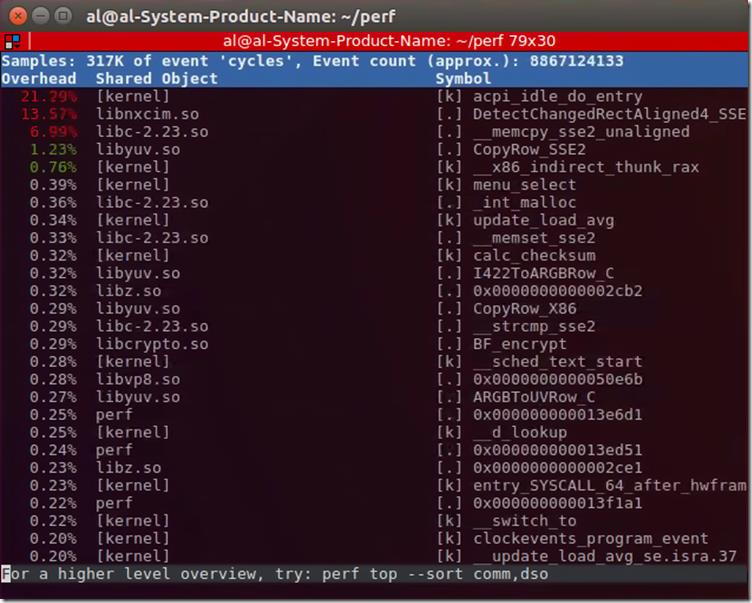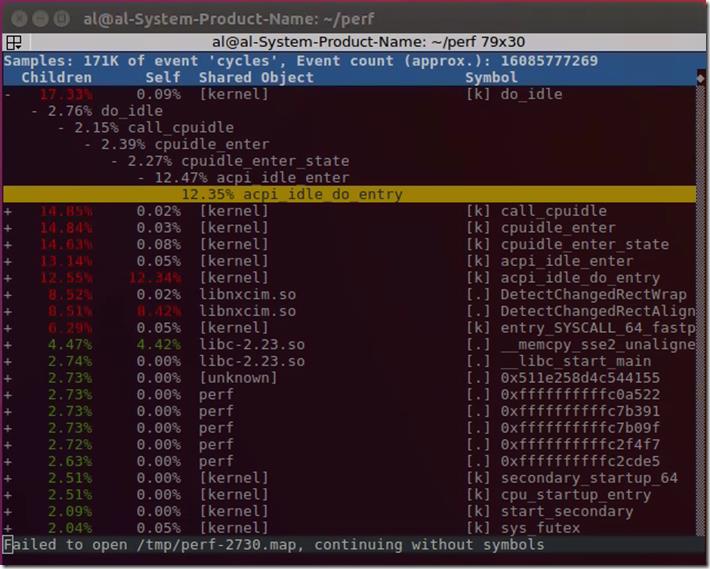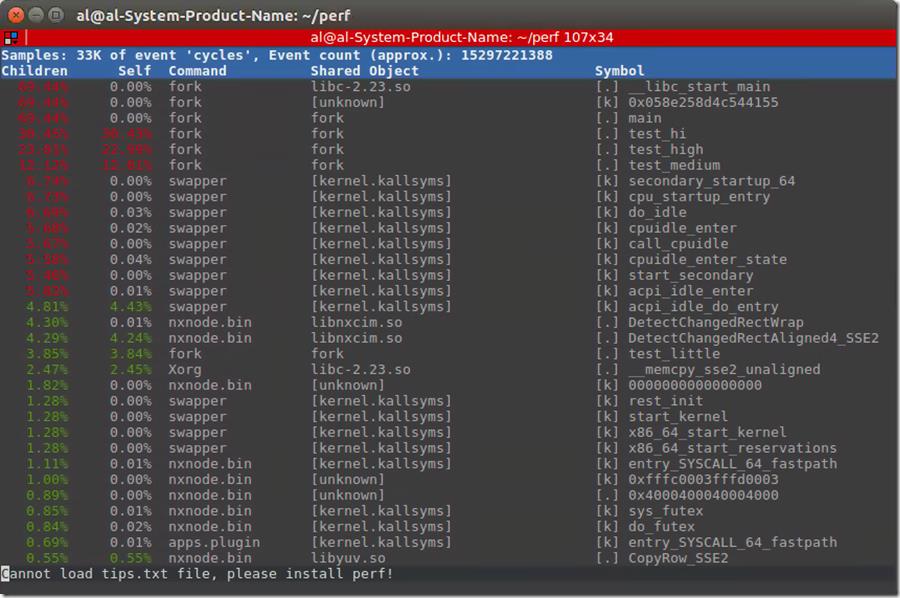系统级性能分析工具perf的介绍与使用
Posted Arnold Lu@南京
tags:
篇首语:本文由小常识网(cha138.com)小编为大家整理,主要介绍了系统级性能分析工具perf的介绍与使用相关的知识,希望对你有一定的参考价值。
测试环境:Ubuntu16.04 + Kernel:4.4.0-31
系统级性能优化通常包括两个阶段:性能剖析(performance profiling)和代码优化。
性能剖析的目标是寻找性能瓶颈,查找引发性能问题的原因及热点代码。
代码优化的目标是针对具体性能问题而优化代码或编译选项,以改善软件性能。
在性能剖析阶段,需要借助于现有的profiling工具,如perf等。在代码优化阶段往往需要借助开发者的经验,编写简洁高效的代码,甚至在汇编级别合理使用各种指令,合理安排各种指令的执行顺序。
perf是一款Linux性能分析工具。Linux性能计数器是一个新的基于内核的子系统,它提供一个性能分析框架,比如硬件(CPU、PMU(Performance Monitoring Unit))功能和软件(软件计数器、tracepoint)功能。
通过perf,应用程序可以利用PMU、tracepoint和内核中的计数器来进行性能统计。它不但可以分析制定应用程序的性能问题(per thread),也可以用来分析内核的性能问题,当然也可以同事分析应用程序和内核,从而全面理解应用程序中的性能瓶颈。
使用perf,可以分析程序运行期间发生的硬件事件,比如instructions retired、processor clock cycles等;也可以分析软件时间,比如page fault和进程切换。
perf是一款综合性分析工具,大到系统全局性性能,再小到进程线程级别,甚至到函数及汇编级别。
perf提供了十八般武器,可以拿大刀大卸八块,也可以拿起手术刀细致分析。
1. 背景知识
1.1 tracepoints
tracepoints是散落在内核源码中的一些hook,它们可以在特定的代码被执行到时触发,这一特定可以被各种trace/debug工具所使用。
perf将tracepoint产生的时间记录下来,生成报告,通过分析这些报告,条有人缘便可以了解程序运行期间内核的各种细节,对性能症状做出准确的诊断。
这些tracepint的对应的sysfs节点在/sys/kernel/debug/tracing/events目录下。
1.2 硬件特性之cache
内存读写是很快的,但是还是无法和处理器指令执行速度相比。为了从内存中读取指令和数据,处理器需要等待,用处理器时间来衡量,这种等待非常漫长。cache是一种SRAM,读写速度非常快,能和处理器相匹配。因此将常用的数据保存在cache中,处理器便无需等待,从而提高性能。cache的尺寸一般都很小,充分利用cache是软件调优非常重要部分。
2. 主要关注点
基于性能分析,可以进行算法优化(空间复杂度和时间复杂度权衡)、代码优化(提高执行速度、减少内存占用)。
评估程序对硬件资源的使用情况,例如各级cache的访问次数、各级cache的丢失次数、流水线停顿周期、前端总线访问次数等。
评估程序对操作系统资源的使用情况,系统调用次数、上下文切换次数、任务迁移次数。
事件可以分为三种:
- Hardware Event由PMU部件产生,在特定的条件下探测性能事件是否发生以及发生的次数。比如cache命中。
- Software Event是内核产生的事件,分布在各个功能模块中,统计和操作系统相关性能事件。比如进程切换,tick数等。
-
Tracepoint Event是内核中静态tracepoint所触发的事件,这些tracepoint用来判断程序运行期间内核的行为细节,比如slab分配器的分配次数等。
3. perf的使用
perf --help之后可以看到perf的二级命令。
| 序号 | 命令 | 作用 |
| 1 | annotate | 解析perf record生成的perf.data文件,显示被注释的代码。 |
| 2 | archive | 根据数据文件记录的build-id,将所有被采样到的elf文件打包。利用此压缩包,可以再任何机器上分析数据文件中记录的采样数据。 |
| 3 | bench | perf中内置的benchmark,目前包括两套针对调度器和内存管理子系统的benchmark。 |
| 4 | buildid-cache | 管理perf的buildid缓存,每个elf文件都有一个独一无二的buildid。buildid被perf用来关联性能数据与elf文件。 |
| 5 | buildid-list | 列出数据文件中记录的所有buildid。 |
| 6 | diff | 对比两个数据文件的差异。能够给出每个符号(函数)在热点分析上的具体差异。 |
| 7 | evlist | 列出数据文件perf.data中所有性能事件。 |
| 8 | inject | 该工具读取perf record工具记录的事件流,并将其定向到标准输出。在被分析代码中的任何一点,都可以向事件流中注入其它事件。 |
| 9 | kmem | 针对内核内存(slab)子系统进行追踪测量的工具 |
| 10 | kvm | 用来追踪测试运行在KVM虚拟机上的Guest OS。 |
| 11 | list | 列出当前系统支持的所有性能事件。包括硬件性能事件、软件性能事件以及检查点。 |
| 12 | lock | 分析内核中的锁信息,包括锁的争用情况,等待延迟等。 |
| 13 | mem | 内存存取情况 |
| 14 | record | 收集采样信息,并将其记录在数据文件中。随后可通过其它工具对数据文件进行分析。 |
| 15 | report | 读取perf record创建的数据文件,并给出热点分析结果。 |
| 16 | sched | 针对调度器子系统的分析工具。 |
| 17 | script | 执行perl或python写的功能扩展脚本、生成脚本框架、读取数据文件中的数据信息等。 |
| 18 | stat | 执行某个命令,收集特定进程的性能概况,包括CPI、Cache丢失率等。 |
| 19 | test | perf对当前软硬件平台进行健全性测试,可用此工具测试当前的软硬件平台是否能支持perf的所有功能。 |
| 20 | timechart | 针对测试期间系统行为进行可视化的工具 |
| 21 | top | 类似于linux的top命令,对系统性能进行实时分析。 |
| 22 | trace | 关于syscall的工具。 |
| 23 | probe | 用于定义动态检查点。 |
全局性概况:
perf list查看当前系统支持的性能事件;
perf bench对系统性能进行摸底;
perf test对系统进行健全性测试;
perf stat对全局性能进行统计;
全局细节:
perf top可以实时查看当前系统进程函数占用率情况;
perf probe可以自定义动态事件;
特定功能分析:
perf kmem针对slab子系统性能分析;
perf kvm针对kvm虚拟化分析;
perf lock分析锁性能;
perf mem分析内存slab性能;
perf sched分析内核调度器性能;
perf trace记录系统调用轨迹;
最常用功能perf record,可以系统全局,也可以具体到某个进程,更甚具体到某一进程某一事件;可宏观,也可以很微观。
pref record记录信息到perf.data;
perf report生成报告;
perf diff对两个记录进行diff;
perf evlist列出记录的性能事件;
perf annotate显示perf.data函数代码;
perf archive将相关符号打包,方便在其它机器进行分析;
perf script将perf.data输出可读性文本;
可视化工具perf timechart
perf timechart record记录事件;
perf timechart生成output.svg文档;
3.0 perf引入的overhead
perf测试不可避免的会引入额外负荷,有三种形式:
counting:内核提供计数总结,多是Hardware Event、Software Events、PMU计数等。相关命令perf stat。
sampling:perf将事件数据缓存到一块buffer中,然后异步写入到perf.data文件中。使用perf report等工具进行离线分析。
bpf:Kernel 4.4+新增功能,可以提供更多有效filter和输出总结。
counting引入的额外负荷最小;sampling在某些情况下会引入非常大的负荷;bpf可以有效缩减负荷。
针对sampling,可以通过挂在建立在RAM上的文件系统来有效降低读写I/O引入的负荷。
mkdir /tmpfs
mount -t tmpfs tmpfs /tmpfs
3.1 perf list
perf list不能完全显示所有支持的事件类型,需要sudo perf list。
同时还可以显示特定模块支持的perf事件:hw/cache/pmu都是硬件相关的;tracepoint基于内核的ftrace;sw实际上是内核计数器。
hw/hardware显示支持的硬件事件相关,如:
al@al-System-Product-Name:~/perf$ sudo perf list hardware
List of pre-defined events (to be used in -e):
branch-instructions OR branches [Hardware event]
branch-misses [Hardware event]
cache-misses [Hardware event]
cache-references [Hardware event]
cpu-cycles OR cycles [Hardware event]
instructions [Hardware event]
stalled-cycles-backend OR idle-cycles-backend [Hardware event]
stalled-cycles-frontend OR idle-cycles-frontend [Hardware event]
sw/software显示支持的软件事件列表:
al@al-System-Product-Name:~/perf$ sudo perf list sw
List of pre-defined events (to be used in -e):
alignment-faults [Software event]
bpf-output [Software event]
context-switches OR cs [Software event]
cpu-clock [Software event]
cpu-migrations OR migrations [Software event]
dummy [Software event]
emulation-faults [Software event]
major-faults [Software event]
minor-faults [Software event]
page-faults OR faults [Software event]
task-clock [Software event]
cache/hwcache显示硬件cache相关事件列表:
al@al-System-Product-Name:~/perf$ sudo perf list cache
List of pre-defined events (to be used in -e):
L1-dcache-load-misses [Hardware cache event]
L1-dcache-loads [Hardware cache event]
L1-dcache-prefetch-misses [Hardware cache event]
L1-dcache-prefetches [Hardware cache event]
L1-icache-load-misses [Hardware cache event]
L1-icache-loads [Hardware cache event]
L1-icache-prefetches [Hardware cache event]
LLC-load-misses [Hardware cache event]
LLC-loads [Hardware cache event]
LLC-stores [Hardware cache event]
branch-load-misses [Hardware cache event]
branch-loads [Hardware cache event]
dTLB-load-misses [Hardware cache event]
dTLB-loads [Hardware cache event]
iTLB-load-misses [Hardware cache event]
iTLB-loads [Hardware cache event]
node-load-misses [Hardware cache event]
node-loads [Hardware cache event]
pmu显示支持的PMU事件列表:
al@al-System-Product-Name:~/perf$ sudo perf list pmu
List of pre-defined events (to be used in -e):
branch-instructions OR cpu/branch-instructions/ [Kernel PMU event]
branch-misses OR cpu/branch-misses/ [Kernel PMU event]
cache-misses OR cpu/cache-misses/ [Kernel PMU event]
cache-references OR cpu/cache-references/ [Kernel PMU event]
cpu-cycles OR cpu/cpu-cycles/ [Kernel PMU event]
instructions OR cpu/instructions/ [Kernel PMU event]
msr/aperf/ [Kernel PMU event]
msr/mperf/ [Kernel PMU event]
msr/tsc/ [Kernel PMU event]
stalled-cycles-backend OR cpu/stalled-cycles-backend/ [Kernel PMU event]
stalled-cycles-frontend OR cpu/stalled-cycles-frontend/ [Kernel PMU event]
tracepoint显示支持的所有tracepoint列表,这个列表就比较庞大:
al@al-System-Product-Name:~/perf$ sudo perf list tracepoint
List of pre-defined events (to be used in -e):
alarmtimer:alarmtimer_cancel [Tracepoint event]
alarmtimer:alarmtimer_fired [Tracepoint event]
alarmtimer:alarmtimer_start [Tracepoint event]
alarmtimer:alarmtimer_suspend [Tracepoint event]
block:block_bio_backmerge [Tracepoint event]
block:block_bio_bounce [Tracepoint event]
block:block_bio_complete [Tracepoint event]
block:block_bio_frontmerge [Tracepoint event]
block:block_bio_queue [Tracepoint event]…
3.2 perf top
默认情况下perf top是无法显示信息的,需要sudo perf top或者echo -1 > /proc/sys/kernel/perf_event_paranoid(在Ubuntu16.04,还需要echo 0 > /proc/sys/kernel/kptr_restrict)。
即可以正常显示perf top如下:
第一列:符号引发的性能事件的比例,指占用的cpu周期比例。
第二列:符号所在的DSO(Dynamic Shared Object),可以是应用程序、内核、动态链接库、模块。
第三列:DSO的类型。[.]表示此符号属于用户态的ELF文件,包括可执行文件与动态链接库;[k]表述此符号属于内核或模块。
第四列:符号名。有些符号不能解析为函数名,只能用地址表示。
关于perf top界面常用命令如下:
h:显示帮助,即可显示详细的帮助信息。
UP/DOWN/PGUP/PGDN/SPACE:上下和翻页。
a:annotate current symbol,注解当前符号。能够给出汇编语言的注解,给出各条指令的采样率。
d:过滤掉所有不属于此DSO的符号。非常方便查看同一类别的符号。
P:将当前信息保存到perf.hist.N中。
perf top常用选项有:
-e <event>:指明要分析的性能事件。
-p <pid>:Profile events on existing Process ID (comma sperated list). 仅分析目标进程及其创建的线程。
-k <path>:Path to vmlinux. Required for annotation functionality. 带符号表的内核映像所在的路径。
-K:不显示属于内核或模块的符号。
-U:不显示属于用户态程序的符号。
-d <n>:界面的刷新周期,默认为2s,因为perf top默认每2s从mmap的内存区域读取一次性能数据。
-g:得到函数的调用关系图。
perf top --call-graph [fractal],路径概率为相对值,加起来为100%,调用顺序为从下往上。
perf top --call-graph graph,路径概率为绝对值,加起来为该函数的热度。
3.3 perf stat
perf stat用于运行指令,并分析其统计结果。虽然perf top也可以指定pid,但是必须先启动应用才能查看信息。
perf stat能完整统计应用整个生命周期的信息。
命令格式为:
perf stat [-e <EVENT> | --event=EVENT] [-a] <command>
perf stat [-e <EVENT> | --event=EVENT] [-a] — <command> [<options>]
下面简单看一下perf stat 的输出:
al@al-System-Product-Name:~/perf$ sudo perf stat
^C
Performance counter stats for \'system wide\':40904.820871 cpu-clock (msec) # 5.000 CPUs utilized
18,132 context-switches # 0.443 K/sec
1,053 cpu-migrations # 0.026 K/sec
2,420 page-faults # 0.059 K/sec
3,958,376,712 cycles # 0.097 GHz (49.99%)
574,598,403 stalled-cycles-frontend # 14.52% frontend cycles idle (49.98%)
9,392,982,910 stalled-cycles-backend # 237.29% backend cycles idle (50.00%)
1,653,185,883 instructions # 0.42 insn per cycle
# 5.68 stalled cycles per insn (50.01%)
237,061,366 branches # 5.795 M/sec (50.02%)
18,333,168 branch-misses # 7.73% of all branches (50.00%)8.181521203 seconds time elapsed
输出解释如下:
cpu-clock:任务真正占用的处理器时间,单位为ms。CPUs utilized = task-clock / time elapsed,CPU的占用率。
context-switches:程序在运行过程中上下文的切换次数。
CPU-migrations:程序在运行过程中发生的处理器迁移次数。Linux为了维持多个处理器的负载均衡,在特定条件下会将某个任务从一个CPU迁移到另一个CPU。
CPU迁移和上下文切换:发生上下文切换不一定会发生CPU迁移,而发生CPU迁移时肯定会发生上下文切换。发生上下文切换有可能只是把上下文从当前CPU中换出,下一次调度器还是将进程安排在这个CPU上执行。
page-faults:缺页异常的次数。当应用程序请求的页面尚未建立、请求的页面不在内存中,或者请求的页面虽然在内存中,但物理地址和虚拟地址的映射关系尚未建立时,都会触发一次缺页异常。另外TLB不命中,页面访问权限不匹配等情况也会触发缺页异常。
cycles:消耗的处理器周期数。如果把被ls使用的cpu cycles看成是一个处理器的,那么它的主频为2.486GHz。可以用cycles / task-clock算出。
stalled-cycles-frontend:指令读取或解码的质量步骤,未能按理想状态发挥并行左右,发生停滞的时钟周期。
stalled-cycles-backend:指令执行步骤,发生停滞的时钟周期。
instructions:执行了多少条指令。IPC为平均每个cpu cycle执行了多少条指令。
branches:遇到的分支指令数。branch-misses是预测错误的分支指令数。
其他常用参数
-a, --all-cpus 显示所有CPU上的统计信息
-C, --cpu <cpu> 显示指定CPU的统计信息
-c, --scale scale/normalize counters
-D, --delay <n> ms to wait before starting measurement after program start
-d, --detailed detailed run - start a lot of events
-e, --event <event> event selector. use \'perf list\' to list available events
-G, --cgroup <name> monitor event in cgroup name only
-g, --group put the counters into a counter group
-I, --interval-print <n>
print counts at regular interval in ms (>= 10)
-i, --no-inherit child tasks do not inherit counters
-n, --null null run - dont start any counters
-o, --output <file> 输出统计信息到文件
-p, --pid <pid> stat events on existing process id
-r, --repeat <n> repeat command and print average + stddev (max: 100, forever: 0)
-S, --sync call sync() before starting a run
-t, --tid <tid> stat events on existing thread id
...
示例
前面统计程序的示例,下面看一下统计CPU信息的示例:
执行sudo perf stat -C 0,统计CPU 0的信息。想要停止后,按下Ctrl+C终止。可以看到统计项一样,只是统计对象变了。
al@al-System-Product-Name:~/perf$ sudo perf stat -C 0
^C
Performance counter stats for \'CPU(s) 0\':2517.107315 cpu-clock (msec) # 1.000 CPUs utilized
2,941 context-switches # 0.001 M/sec
109 cpu-migrations # 0.043 K/sec
38 page-faults # 0.015 K/sec
644,094,340 cycles # 0.256 GHz (49.94%)
70,425,076 stalled-cycles-frontend # 10.93% frontend cycles idle (49.94%)
965,270,543 stalled-cycles-backend # 149.86% backend cycles idle (49.94%)
623,284,864 instructions # 0.97 insn per cycle
# 1.55 stalled cycles per insn (50.06%)
65,658,190 branches # 26.085 M/sec (50.06%)
3,276,104 branch-misses # 4.99% of all branches (50.06%)2.516996126 seconds time elapsed
如果需要统计更多的项,需要使用-e,如:
| perf stat -e task-clock,context-switches,cpu-migrations,page-faults,cycles,stalled-cycles-frontend,stalled-cycles-backend,instructions,branches,branch-misses,L1-dcache-loads,L1-dcache-load-misses,LLC-loads,LLC-load-misses,dTLB-loads,dTLB-load-misses ls |
结果如下,关注的特殊项也纳入统计。
al@al-System-Product-Name:~/perf$ sudo perf stat -e task-clock,context-switches,cpu-migrations,page-faults,cycles,stalled-cycles-frontend,stalled-cycles-backend,instructions,branches,branch-misses,L1-dcache-loads,L1-dcache-load-misses,LLC-loads,LLC-load-misses,dTLB-loads,dTLB-load-misses ls
Performance counter stats for \'ls\':
2.319422 task-clock (msec) # 0.719 CPUs utilized
0 context-switches # 0.000 K/sec
0 cpu-migrations # 0.000 K/sec
89 page-faults # 0.038 M/sec
2,142,386 cycles # 0.924 GHz
659,800 stalled-cycles-frontend # 30.80% frontend cycles idle
725,343 stalled-cycles-backend # 33.86% backend cycles idle
1,344,518 instructions # 0.63 insn per cycle
# 0.54 stalled cycles per insn
<not counted> branches
<not counted> branch-misses
<not counted> L1-dcache-loads
<not counted> L1-dcache-load-misses
<not counted> LLC-loads
<not counted> LLC-load-misses
<not counted> dTLB-loads
<not counted> dTLB-load-misses0.003227507 seconds time elapsed
3.4 perf bench
perf bench作为benchmark工具的通用框架,包含sched/mem/numa/futex等子系统,all可以指定所有。
perf bench可用于评估系统sched/mem等特定性能。
perf bench sched:调度器和IPC机制。包含messaging和pipe两个功能。
perf bench mem:内存存取性能。包含memcpy和memset两个功能。
perf bench numa:NUMA架构的调度和内存处理性能。包含mem功能。
perf bench futex:futex压力测试。包含hash/wake/wake-parallel/requeue/lock-pi功能。
perf bench all:所有bench测试的集合
3.4.1 perf bench sched all
测试messaging和pipi两部分性能。
3.4.1.1 sched messaging评估进程调度和核间通信
sched message 是从经典的测试程序 hackbench 移植而来,用来衡量调度器的性能,overhead 以及可扩展性。
该 benchmark 启动 N 个 reader/sender 进程或线程对,通过 IPC(socket 或者 pipe) 进行并发的读写。一般人们将 N 不断加大来衡量调度器的可扩展性。
sched message 的用法及用途和 hackbench 一样,可以通过修改参数进行不同目的测试:
-g, --group <n> Specify number of groups
-l, --nr_loops <n> Specify the number of loops to run (default: 100)
-p, --pipe Use pipe() instead of socketpair()
-t, --thread Be multi thread instead of multi process
测试结果:
al@al-System-Product-Name:~/perf$ perf bench sched all
# Running sched/messaging benchmark...
# 20 sender and receiver processes per group
# 10 groups == 400 processes runTotal time: 0.173 [sec]
# Running sched/pipe benchmark...
# Executed 1000000 pipe operations between two processesTotal time: 12.233 [sec]
12.233170 usecs/op
81744 ops/sec
使用pipe()和socketpair()对测试影响:
1. perf bench sched messaging
# Running \'sched/messaging\' benchmark:
# 20 sender and receiver processes per group
# 10 groups == 400 processes runTotal time: 0.176 [sec]
2. perf bench sched messaging -p# Running \'sched/messaging\' benchmark:
# 20 sender and receiver processes per group
# 10 groups == 400 processes runTotal time: 0.093 [sec]
可见socketpair()性能要明显低于pipe()。
3.4.1.2 sched pipe评估pipe性能
sched pipe 从 Ingo Molnar 的 pipe-test-1m.c 移植而来。当初 Ingo 的原始程序是为了测试不同的调度器的性能和公平性的。
其工作原理很简单,两个进程互相通过 pipe 拼命地发 1000000 个整数,进程 A 发给 B,同时 B 发给 A。因为 A 和 B 互相依赖,因此假如调度器不公平,对 A 比 B 好,那么 A 和 B 整体所需要的时间就会更长。
al@al-System-Product-Name:~/perf$ perf bench sched pipe
# Running \'sched/pipe\' benchmark:
# Executed 1000000 pipe operations between two processesTotal time: 12.240 [sec]
12.240411 usecs/op
81696 ops/sec
3.4.2 perf bench mem all
该测试衡量 不同版本的memcpy/memset/ 函数处理一个 1M 数据的所花费的时间,转换成吞吐率。
al@al-System-Product-Name:~/perf$ perf bench mem all
# Running mem/memcpy benchmark...
# function \'default\' (Default memcpy() provided by glibc)
# Copying 1MB bytes ...1.236155 GB/sec.
..
3.4.3 perf bench futex
Futex是一种用户态和内核态混合机制,所以需要两个部分合作完成,linux上提供了sys_futex系统调用,对进程竞争情况下的同步处理提供支持。
所有的futex同步操作都应该从用户空间开始,首先创建一个futex同步变量,也就是位于共享内存的一个整型计数器。
当进程尝试持有锁或者要进入互斥区的时候,对futex执行"down"操作,即原子性的给futex同步变量减1。如果同步变量变为0,则没有竞争发生, 进程照常执行。
如果同步变量是个负数,则意味着有竞争发生,需要调用futex系统调用的futex_wait操作休眠当前进程。
当进程释放锁或 者要离开互斥区的时候,对futex进行"up"操作,即原子性的给futex同步变量加1。如果同步变量由0变成1,则没有竞争发生,进程照常执行。
如果加之前同步变量是负数,则意味着有竞争发生,需要调用futex系统调用的futex_wake操作唤醒一个或者多个等待进程。
al@al-System-Product-Name:~/perf$ perf bench futex all
# Running futex/hash benchmark...
Run summary [PID 3806]: 5 threads, each operating on 1024 [private] futexes for 10 secs.[thread 0] futexes: 0x4003d20 ... 0x4004d1c [ 4635648 ops/sec ]
[thread 1] futexes: 0x4004d30 ... 0x4005d2c [ 4611072 ops/sec ]
[thread 2] futexes: 0x4005e70 ... 0x4006e6c [ 4254515 ops/sec ]
[thread 3] futexes: 0x4006fb0 ... 0x4007fac [ 4559360 ops/sec ]
[thread 4] futexes: 0x40080f0 ... 0x40090ec [ 4636262 ops/sec ]Averaged 4539371 operations/sec (+- 1.60%), total secs = 10
# Running futex/wake benchmark...
Run summary [PID 3806]: blocking on 5 threads (at [private] futex 0x96b52c), waking up 1 at a time.[Run 1]: Wokeup 5 of 5 threads in 0.0270 ms
[Run 2]: Wokeup 5 of 5 threads in 0.0370 ms...
3.4 perf record
运行一个命令,并将其数据保存到perf.data中。随后,可以使用perf report进行分析。
perf record和perf report可以更精确的分析一个应用,perf record可以精确到函数级别。并且在函数里面混合显示汇编语言和代码。
创建一个fork.c文件用于测试:
#include <stdio.h> void test_little(void) { int i,j; for(i = 0; i < 30000000; i++) j=i; } void test_mdedium(void) { int i,j; for(i = 0; i < 60000000; i++) j=i; } void test_high(void) { int i,j; for(i = 0; i < 90000000; i++) j=i; } void test_hi(void) { int i,j; for(i = 0; i < 120000000; i++) j=i; } int main(void) { int i, pid, result; for(i = 0; i<2; i++) { result = fork(); if(result>0) printf("i=%d parent parent=%d current=%d child=%d\\n", i, getppid(), getpid(), result); else printf("i=%d child parent=%d current=%d\\n", i, getppid(), getpid()); if(i==0) { test_little(); sleep(1); } else { test_mdedium(); sleep(1); } } pid = wait(NULL); test_high(); printf("pid=%d wait=%d\\n", getpid(), pid); sleep(1); pid = wait(NULL); test_hi(); printf("pid=%d wait=%d\\n", getpid(), pid); return 0; }
编译fork.c文件gcc fork.c -o fork-g -O0,同时可以使用此方法分析是否选择编译优化产生的结果。-g是只能callgraph功能,-O0是关闭优化。
常用选项
-e record指定PMU事件
--filter event事件过滤器
-a 录取所有CPU的事件
-p 录取指定pid进程的事件
-o 指定录取保存数据的文件名
-g 使能函数调用图功能
-C 录取指定CPU的事件
sudo perf record -a -g ./fork:会在当前目录生成perf.data文件。
sudo perf report --call-graph none结果如下,后面结合perf timechart分析.
上图看上去比较乱,如果想只看fork产生的信息:
sudo perf report --call-graph none -c fork
可以看出只显示了fork程序的相关符号及其占用率。


